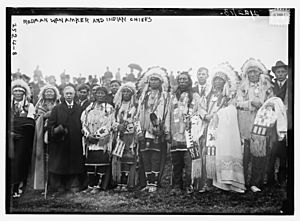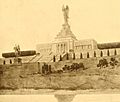National American Indian Memorial facts for kids
The National American Indian Memorial was a huge monument that was planned a long time ago. It was meant to honor American Indians. The idea was to build it on a tall cliff overlooking the Narrows. This is the main entrance to New York Harbor. The main part of the memorial was going to be a giant statue. It would show an American Indian warrior. This statue would be about 165-foot-tall (50 m). That's taller than the Statue of Liberty! The statue would stand on a large building. This building would have a museum inside, showing native cultures. Construction started in 1913, but the project was never finished. Today, there is no sign of it left.
Contents
Where It Was Going to Be Built
The memorial was planned for Fort Tompkins on Staten Island, New York. Fort Tompkins is part of a bigger area called Fort Wadsworth. It sits high on a cliff above the west side of the Narrows. The United States government still owns this land.
For many years, Fort Wadsworth and Fort Hamilton (on the other side of the Narrows) protected New York City's harbor. Almost all ocean-going ships heading to New York pass this spot. So, the monument would have been very easy to see. Visitors would have seen it long before they saw the Statue of Liberty.
The Story Behind the Memorial
The idea for this project came from Rodman Wanamaker. He was from the family that owned the Wanamaker department store. He worked with "Doctor" Joseph Kossuth Dixon, who led the store's education department.
In 1909, Wanamaker suggested the memorial at a fancy dinner in New York. Famous people like Buffalo Bill Cody were there. Wanamaker said the project would be paid for by private donations.
On April 4, 1911, the United States Congress passed a law. This law set aside the government land needed for the project. But Congress did not give any money for building it.
Designing the Monument
Two famous artists, sculptor Daniel Chester French and architect Thomas Hastings, created the first ideas. They drew a general plan for the memorial. It showed the statue of an Indian standing on a pyramid-like base. This base would have a grand entrance with columns. Inside, there would be museums, art galleries, and libraries. Around the building, there would be gardens with statues of bison and Indians on horseback.
Groundbreaking Ceremony
On a rainy day in 1913, President William Howard Taft officially started the project. He used a silver shovel to break ground. It was a huge ceremony! There were 21-gun salutes from nearby Battery Weed and a navy ship. About 32 or 33 American Indian chiefs were also there. This included chiefs like Red Hawk and Two Moons.
Why It Was Never Finished
Soon after, people found out that Wanamaker was not going to pay for the whole project himself. Instead, he was going to be the main person raising money. But very little money was actually collected. Newspapers that had supported the project earlier started calling it a "fake charity."
Then, World War I started in 1914. People lost interest in the project, especially since it was on land used for harbor defense. A bronze plaque that marked the spot where the ground was broken disappeared by the 1960s. The memorial was never built.
Images for kids
-
William Howard Taft at the memorial's groundbreaking ceremony.





